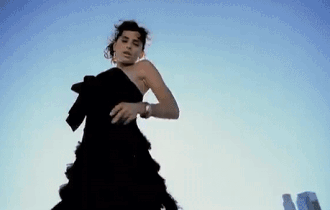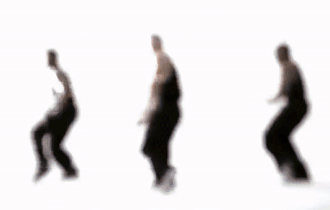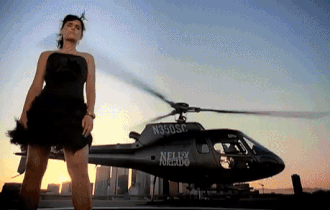Released: 5th March 2007
Writers: Nelly Furtado / Timothy Mosley / Nate Hills
Peak position: #10
Chart run: 37-19-16-14-11-10-11-14-15-18-25-23-24-27-34-29-29-29-31-37-45-54-26-29-27-36-44-42-45-58-66
Billboard Hot 100 chart run: 93-66-25-12-6-6-6-10-5-4-3-3-2-1-3-6-10-10-11-11-12-16-17-22-30-33-35-39-44-42
Four singles into the Loose campaign, Nelly Furtado was still full of surprises, as Say It Right ushered in a new era for the UK charts.

Nelly Furtado’s comeback in the mid-’00s was right up there among the very biggest. After experiencing a sophomore slump with Folklore, she joined forces with Timbaland and Danja to create a pop/R&B album that was bang on trend and repositioned her as an A-list act overnight. Some critics were quick to label this as yet another example of a singer sexualising her image to sell, particularly when songs like Maneater and Promiscuous – which reached #1 in the UK and America, respectively – led the campaign. But there was so much more to Loose than that. It was the first album released through Timbaland’s Mosley Music Group label, which operated under Universal (the company had acquired Nelly Furtado after buying out Dreamworks, with whom she’d previously signed). While still rooted in the mainstream, there was also a strong sense of creative freedom and experimentation, which is perfectly captured in Say It Right.

This is a phenomenally crafted piece of music that still has the identifiable hallmarks of a Timbaland production – the obligatory: “Frk frk” voice samples are correct and present – but then takes everything you expect and turns it on its head. The sparse, syncopated beats are so proximal to the speaker that they actually reverberate (it’s even more effective through high-resolution headphones), and yet, there’s a juxtaposition between that and Timbaland’s looped vocals – “Hey…oh, hey” – which sound as if they’ve come from an entirely different time and place. The way his echoed vocals are woven into the instrumental creates an other-worldly effect, which is gently, hauntingly eery, but never quite to the point of being unsettling. The Eurythmics’ track Here Comes The Rain Again was cited as a significant inspiration for Say It Right. There’s a strong influence of that same atmospheric quality, albeit with more than two decades of advancements in production, technology and chart trends.

It’s easy to listen to the song and assume the basis of its effectiveness predominantly stems from the backing track. But take Nelly Furtado out of the equation (an instrumental version was included on the promotional single), and it shows how much Say It Right was a meeting of minds. The way her performance is wrapped around Timbaland’s interludes makes it feel – intentionally – slightly stilted and disconnected: “In the day…in the night…say it right…say it all; you either got it…or you don’t…you either stand…or you fall”. The distinctive tone of Nelly Furtado’s voice plays wonderfully into her reading of the lyrics, which often feels objectively matter of fact and uncharacteristically cold. The fact that Say It Right is never coherently specific as to what it’s about (“From my hands…I could give you…something…that I made…from my mouth…I could sing you…another brick…that I laid”) adds a further layer of abstract separation to the experience.

And yet, if the song stopped at being a haunting piece of introspective pop music, it would not have connected in the way it did. The way the chorus blends the vocals and production elements into consuming hypnotic, almost-trance-like melody is phenomenal: “Oh you don’t mean nothing at all to me (hey…oh, hey), no you don’t mean nothing at all to me (hey…oh, hey), but you got what it takes to set me free (hey…oh, hey), oh you could mean everything to me (hey…oh, hey)”. Perhaps the most engrossing thing about Say It Right is that it was crafted around a transportive emotion rather than a sentiment that can be quantifiably expressed in words. In that respect, it will always possess an air of intangible mystery that puts the song tantalisingly just beyond the point of complete comprehension.

The music video for Say It Right was filmed back-to-back with All Good Things (Come To An End), which all too often means one track getting more attention than the other. But that is never apparent here, as both received different – yet entirely appropriate – visual treatments. In a nutshell, Say It Right is every bit the image of Nelly Furtado as one of the biggest pop artists in the world, and not just because it opens with her emerging onto a skyscraper from a helicopter branded with her logo. She radiates star quality in terms of styling (those blunt bangs are fierce) and screen presence. The most iconic sequence features her and Timbaland performing against a white background; the affinity of their professional relationship is framed in an intrusively close shot and unconventionally cropped. It’s easily one of the most recognisable images associated with both Say It Right and indeed Loose as a whole. There isn’t a bad look here at all, and whether it’s Nelly Furtado performing on a bridge or dancing in the rain, everything about the video communicates – with no context required – that this is a singer at the height of her powers.

Say It Right was a huge success globally, but also signified a watershed moment for the charts in the UK. Rules around the inclusion of downloads had been slowly relaxing, but the requirement for singles to be physically available was finally dropped at the start of 2007. However, it was older hits that noticeably benefitted at first. Chasing Cars by Snow Patrol returned to #9 – and remained in the top 100 for a total of 149 weeks (to date) – while Billie Piper’s Honey To The Bee re-entered at #17 after Chris Moyles decided to test the system as a joke. Thus, everyone was still waiting to see what this meant in real terms, and there’s a very reasonable argument that Say It Right was, in fact, the first major contemporary hit of the download era. It entered the chart at #37 and eventually reached #10 after six weeks. This was modest compared to almost every other territory, but no less significant; for at the time, it was the highest-peaking single not released physically and ended up spending 31 weeks in the top 75. Although it’s damning evidence of how far the bottom had fallen out of the market that 2007 marked an upswing in sales, yet Say It Right still only sold just over 200,000 copies.

Elsewhere, the song was a much more visible hit. In America, it earned Nelly Furtado her second #1 single and reached the top ten across Europe and Australia. The track also spurred a resurgence in Loose, which – in its 44th week on the chart – achieved a new peak of #4 in the UK, with the fact that this was the only way to own Say It Right physically no doubt factoring in, to some extent. The album was already incredibly successful, but pulling a song like this out of the bag relatively late into the campaign would ultimately help it go on to be a million-seller.

Although Nelly Furtado enjoyed a lot of success during this era, she ultimately felt conflicted over what people were actually buying into here; was it the music or just the image? Subsequently, she made little – if any – attempt to recreate or continue the sound of Loose, which might have been a puzzling move to some. However, there’s no doubt it was the right one for Nelly Furtado (her most recent album, The Ride, was independently released). The by-product of that approach – certainly concerning Say It Right – is how much its legacy has been preserved. This is a true one-off that stands as a towering monument to a specific period in pop music history. And it could scarcely have been a more perfect song to mark a bold new era for the UK chart.



